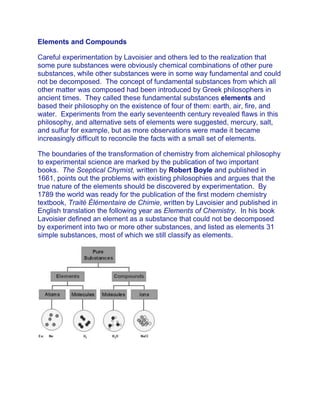
Elements and compounds
- 1. Elements and Compounds Careful experimentation by Lavoisier and others led to the realization that some pure substances were obviously chemical combinations of other pure substances, while other substances were in some way fundamental and could not be decomposed. The concept of fundamental substances from which all other matter was composed had been introduced by Greek philosophers in ancient times. They called these fundamental substances elements and based their philosophy on the existence of four of them: earth, air, fire, and water. Experiments from the early seventeenth century revealed flaws in this philosophy, and alternative sets of elements were suggested, mercury, salt, and sulfur for example, but as more observations were made it became increasingly difficult to reconcile the facts with a small set of elements. The boundaries of the transformation of chemistry from alchemical philosophy to experimental science are marked by the publication of two important books. The Sceptical Chymist, written by Robert Boyle and published in 1661, points out the problems with existing philosophies and argues that the true nature of the elements should be discovered by experimentation. By 1789 the world was ready for the publication of the first modern chemistry textbook, Traité Élémentaire de Chimie, written by Lavoisier and published in English translation the following year as Elements of Chemistry. In his book Lavoisier defined an element as a substance that could not be decomposed by experiment into two or more other substances, and listed as elements 31 simple substances, most of which we still classify as elements.
